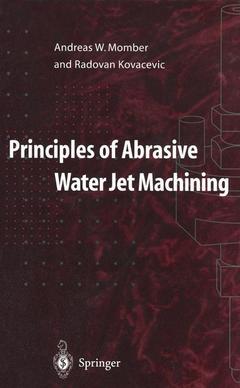Principles of Abrasive Water Jet Machining, Softcover reprint of the original 1st ed. 1998
Langue : Anglais
Auteurs : Momber Andreas W., Kovacevic Radovan

Abrasive water jet machining was introduced to manufacturing ten years ago and has been increasingly used for treating hard-to-machine and multi-layered materials and as an alternative tool for milling, turning, drilling and polishing. This is the first comprehensive review of the technique, dealing with a broad range of issues including mixing and acceleration processes, material removal mechanisms, process optimization and fluid mechanics. Explanations are given as the book follows the development of an abrasive water jet machining process, from tool generation through to machining results, supervision and control. This methodical journey through the field is marked by drawings, graphs and tables, many of which are being published here for the first time. Though the book is written at an academic level, it focuses very much on practical applications, which reflects the authors' extensive involvement with both laboratory research and industrial practices.
1 Introduction.- 1.2 Classification of High-Speed Fluid Jets.- 1.3 State-of-the-Art Application of the Water-Jet Technique.- 2 Classification and Characterization of Abrasive Materials.- 2.1 Classification and Properties of Abrasive Materials.- 2.2 Abrasive-Material Structure and Hardness.- 2.3 Abrasive-Particle Shape Parameters.- 2.4 Abrasive-Particle Size Distribution and Abrasive-Particle Diameter.- 2.5 Number and Kinetic Energy of Abrasive Particles.- 3 Generation of Abrasive Water Jets.- 3.1 Properties and Structure of High-Speed Water Jets.- 3.2 Abrasive Particle — Water Jet Mixing Principles in Injection Systems.- 3.3 Abrasive Suction in Injection Systems.- 3.4 Abrasive-Particle Acceleration in Injection Systems.- 3.5 Abrasive-Particle Fragmentation in Injection Systems.- 3.6 Focus Wear in Injection Systems.- 3.7 Generation of Suspension-Abrasive Water Jets.- 4 Structure and Hydrodynamics of Abrasive Water Jets.- 4.1 General Structure of Injection-Abrasive Water Jets.- 4.2 Phase Distributions in Injection-Abrasive Water Jets.- 4.3 Abrasive-Particle Velocity Distribution in Injection-Abrasive Water Jets.- 4.4 Structure of Suspension-Abrasive Water Jets.- 5 Material-Removal Mechanisms in Abrasive Water-Jet Machining.- 5.1 Erosion by Single Solid-Particle Impact.- 5.2 Micro-Mechanisms of Abrasive-Particle Material-Removal in Abrasive Water-Jet Machining.- 5.3 Material Removal by the High-Speed Water Flow.- 5.4 Macro-Mechanisms of Abrasive Water-Jet Material Removal.- 5.5 Energy Balance of Abrasive Water-Jet Material Removal.- 5.6 Erosion-Debris Generation and Acceleration.- 5.7 Damping Effects in Abrasive Water-Jet Material Removal.- 5.8 Heat Generation During Abrasive Water-Jet Material Removal.- 5.9 Target-Material Property Influence on Material Removal.- 6Modeling of Abrasive Water Jet Cutting Processes.- 6.1 Introduction.- 6.2 Volume-Displacement Models.- 6.3 Energy-Conservation Models.- 6.4 Regression Models.- 6.5 Kinetic Model of the Abrasive Water-Jet Cutting Process.- 6.6 Fuzzy Rule-Based Model of the Abrasive Water-Jet Cutting Process.- 6.7 Numerical Models.- 7 Process Parameter Optimization.- 7.1 Definition of Process and Target Parameters.- 7.2 Influence of Hydraulic Process Parameters.- 7.3 Influence of Cutting Parameters.- 7.4 Influence of Mixing Parameters.- 7.5 Influence of Abrasive Parameters.- 8 Geometry, Topography and Integrity of Abrasive Water-Jet Machined Parts.- 8.1 Cut Geometry and Structure.- 8.2 Topography of Abrasive Water-Jet Generated Surfaces.- 8.3 Integrity of Abrasive Water-Jet Generated Surfaces.- 9 Alternative Machining Operations with Abrasive Water Jet.- 9.1 Capability of Abrasive Water Jets for Alternative Machining.- 9.2 Milling with Abrasive Water Jets.- 9.3 Turning with Abrasive Water Jets.- 9.4 Piercing with Abrasive Water Jets.- 9.5 Hole Trepanning and Deep-Hole Drilling with Abrasive Water Jets.- 9.6 Polishing with Abrasive Water Jet.- 9.7 Screw-Thread Machining with Abrasive Water Jets.- 10 Control and Supervision of Abrasive Water-Jet Machining Processes.- 10.1 General Aspects of Process Control.- 10.2 Control of the Abrasive-Particle Suction Process.- 10.3 Control of Water-Orifice Condition and Wear.- 10.4 Control of Focus Condition and Wear.- 10.5 Measurement and Control of Abrasive Water-Jet Velocity.- 10.6 Measurement and Control of Abrasive Water-Jet Structure.- 10.7 Control of Material-Removal Processes.- 10.8 Control of Depth of Penetration.- 10.9 Control of the Generated Surface Topography.- 10.10 Expert Systems for Abrasive Water-Jet Machining.- References.
This is the first comprehensive review of abrasive water jet machining technology. The use of the technique is on the increase, so this work is part of an expanding market * It provides a wealth of practical applications, so will be invaluable to practitioners within the industry * The methodical approach and many illustrations mean that it also has academic appeal
Date de parution : 02-2012
Ouvrage de 394 p.
15.5x23.5 cm
Mots-clés :
cutting; development; fluid mechanics; fuzzy; machining; manufacturing; mechanics; modeling; fluid- and aerodynamics
© 2024 LAVOISIER S.A.S.



